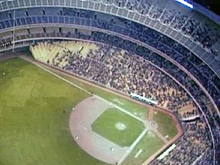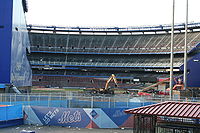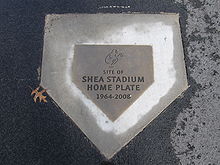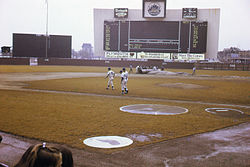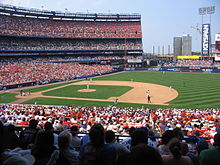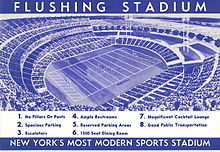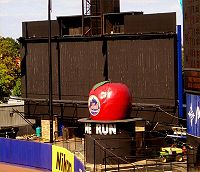- Shea Stadium
-
This article is about the former home of the New York Mets. For other uses, see Shea Stadium (disambiguation).
William A. Shea Municipal Stadium Shea Stadium 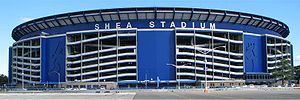
Location 123-01 Roosevelt Avenue
Flushing, New York 11368-1699Coordinates 40°45′20″N 73°50′53″W / 40.75556°N 73.84806°WCoordinates: 40°45′20″N 73°50′53″W / 40.75556°N 73.84806°W Broke ground October 28, 1961 Opened April 17, 1964 Closed September 28, 2008 (Final game) Demolished October 14, 2008- February 18, 2009 Owner City of New York Operator New York City Department of Parks and Recreation Surface Kentucky Bluegrass Construction cost US$28.5 million
($202 million in 2011 dollars[1])Architect Praeger-Kavanagh-Waterbury[2] General Contractor Carlin-Crimmins J.V.[3] Capacity Baseball: 57,333[4]
Football: 60,372[5]Field dimensions Left Field
Left Field ('64-'77)
Medium Left-Center
Left-Center
Left-Center (deep)
Center
Right-Center (deep)
Right-Center
Medium Right-Center
Right Field
Right Field ('64-'77)338 feet (103 m)
341 (104)
358 (109)
371 (113)
396 (121)
410 (125)
396 (121)
371 (113)
358 (109)
338 (103)
341 (104)Tenants New York Mets (MLB) (1964-2008)
New York Jets (AFL / NFL) (1964-1983)
New York Yankees (MLB) (1974-1975)
New York Giants (NFL) (1975)William A. Shea Municipal Stadium, usually shortened to Shea Stadium or just Shea (
 /ˈʃeɪ/), was a stadium in the New York City borough of Queens, in Flushing Meadows–Corona Park.[6] It was the home baseball park of Major League Baseball's New York Mets from 1964 to 2008. Originally built as a multi-purpose stadium, Shea was also the home of the New York Jets football team from 1964 to 1983. It was named in honor of William A. Shea, the man who brought National League baseball back to New York. It was demolished in 2009 to furnish additional parking for the adjacent Citi Field, the current home of the Mets.
/ˈʃeɪ/), was a stadium in the New York City borough of Queens, in Flushing Meadows–Corona Park.[6] It was the home baseball park of Major League Baseball's New York Mets from 1964 to 2008. Originally built as a multi-purpose stadium, Shea was also the home of the New York Jets football team from 1964 to 1983. It was named in honor of William A. Shea, the man who brought National League baseball back to New York. It was demolished in 2009 to furnish additional parking for the adjacent Citi Field, the current home of the Mets.Contents
History
Planning and construction
The origins of Shea Stadium go back to the controversial west coast relocation of the Dodgers and the Giants which left New York without a National League presence. New York City official Robert Moses tried to interest Brooklyn Dodgers owner Walter O'Malley in this site as the location for a new Dodger stadium, but O'Malley refused, unable to agree on location, ownership and lease terms. O'Malley preferred to pay construction costs himself so he would own the stadium outright. He wanted total control over revenue from parking, concessions, and other events. The City, by contrast, wanted to build the stadium, rent it, and retain these ancillary revenue rights to pay off its construction bonds.[7] Additionally, O'Malley wanted to build his new stadium in Brooklyn, while Moses insisted on Flushing Meadows. When Los Angeles offered O'Malley what the City of New York wouldn't—complete and absolute ownership of the facility—he left for southern California in a preemptive bid to install the Dodgers there before a new or existing major league franchise could beat him to it. At the same time, Horace Stoneham moved his New York Giants to the San Francisco Bay Area, ensuring that there would be two west coast NL teams and preserving the longstanding rivalry with O'Malley's Dodgers that continues to this day.
In 1960, the National League agreed to grant an expansion franchise to the owners of the New York franchise in the abortive Continental League, provided that a new stadium be built. Mayor Robert Wagner, Jr. had to personally wire all National League owners and assure them that the city would build a park.
On October 6, 1961, the Mets signed a 30-year stadium lease, with an option for a 10-year renewal. Rent for what was originally budgeted as a $9 million facility was set at $450,000 annually, with a reduction of $20,000 each year until it reaches $300,000 annually.
The Mets' inaugural season (1962) was played in the Polo Grounds, with original plans calling for the team to move to a new stadium in 1963. In October 1962, Mets official Tom Meany said, "Only a series of blizzards or some other unforeseen trouble might hamper construction." That unforeseen trouble surfaced in a number of ways: the severe winter of 1962-1963, along with the bankruptcies of two subcontractors and labor issues. The end result was that both the Mets and Jets played at the Polo Grounds for one more year.
It was originally to be called "Flushing Meadow Park Municipal Stadium"[8] - the name of the public park on which it was built - but a movement was launched to name it in honor of William A. Shea, the man who brought National League baseball back to New York.
Opening
After 29 months and $28.5 million, Shea Stadium opened on April 17, 1964, with the Pittsburgh Pirates beating the Mets 4-3 before a crowd of 50,312.[9]
Demolition
In accordance with New York City law, Shea Stadium was dismantled, rather than imploded.[10] The company with the rights to sell memorabilia was given two weeks after the final game to remove seats, signage and other potentially saleable/collectable items before demolition was to begin. The seats were the first ($869 per pair plus tax, a combination of '86 and '69),[11] followed by other Shea memorabilia such as the foul poles, dugouts, stadium signage, and the giant letters that spell out "SHEA" at the front of the building.
After salvaging operations concluded, actual demolition of the ballpark began on October 14, 2008. On October 18, the scoreboard in right field was demolished, with the bleachers, batter's eye and bullpens soon to follow.[12]
By November 10, the field, dugouts and the rest of the field level seats had been demolished.[13]
By mid-December, all of the Loge level seats and a good portion of the Mezzanine level seating were gone as well, leaving only the outer shell remaining.
Demolition work on the upper deck began by January 1, 2009. The next day, all that remained of sections 26-48 of the upper deck was the steel framework. By January 8, the steel framework for sections 36-48 of the upper deck had been completely removed; all that remained of the "Live & In Person" advertising banner at the top above Gate A was the extreme right portion with the Shea Stadium Final Season logo. As of January 15, the far left field portion of Shea was completely demolished and the left field upper deck (sections 25-47) was stripped to its steel framework. The remaining letters at the top of the ballpark behind home plate were taken down on January 21. Approximately two-thirds of the stadium's outer superstructure was gone by January 24.
On January 31, Mets fans all over New York came to Shea for one final farewell to Shea Stadium. Fans took a tour of the site, told stories, and sang songs.[14] The last remaining section of seats was demolished on February 18. Fans stood in awe as the remaining structure of Shea Stadium (one section of ramps) was torn down at 11:22 AM that morning.[15][16]
Shea's home plate, pitcher's mound, and the bases are immortalized in Citi Field's parking lot, and feature engravings of the neon baseball players that once graced the exterior of the stadium.[17]
Stadium usage
Sports
Baseball
Shea Stadium was the home of the New York Mets since its inception in 1964, and hosted the Major League Baseball All-Star Game that same year, with Johnny Callison of the Philadelphia Phillies hitting a home run in the ninth inning to win the only Mid-Summer Classic held in the Queens ballpark. A month earlier on Father's Day, Callison's teammate, future Hall of Fame member and United States Senator Jim Bunning, pitched a perfect game against the Mets.[18]
The stadium was often criticized by baseball purists for many reasons, even though it was retrofitted to be a baseball-only stadium after the Jets left. The upper deck was one of the highest in the majors. The lower boxes were farther from the field than similar seats in other parks because they were still on the rails that swiveled the boxes into position for football.[19] Outfield seating was always rather sparse, in part because the stadium was intended to be fully enclosed.
At one time, Shea's foul territory was one of the most expansive in the majors, which was typical for ballparks that were built during this era.[19] However, seats added over the years in the lower level greatly reduced the size of foul territory by the dawn of the 21st century. Also on the plus side, Shea always used a natural grass surface. This stood in contrast to multi-purpose stadiums such as Three Rivers Stadium and Riverfront Stadium, which were built in the same era and style and used artificial turf instead of natural grass.
Shea Stadium hosted postseason baseball in 1969, 1973, 1986, 1988, 1999, 2000 and 2006; it hosted the World Series in 1969, 1973, 1986, and 2000. Shea Stadium had the distinction of being the home of the 1969 "Miracle Mets" -- a team led by former Brooklyn Dodger Gil Hodges that defied 100-1 odds and won the World Series, this after recording seven straight seasons in last or next-to-last place. Shea became famous for the bedlam that took place after the Mets won the decisive Game 5 of the 1969 World Series, as fans stormed the field in celebration. A similar scene took place a few weeks earlier after the Mets defeated the Atlanta Braves in the first National League Championship Series to win the pennant.
Tommie Agee, Lenny Dykstra, Todd Pratt, Robin Ventura, and Benny Agbayani have all hit post-season, game-winning home runs at Shea.
Tommie Agee was the only player in the history of the ballpark to hit a home run into the upper deck in left field. The spot was marked with a sign featuring Agee's number, and the date of the event, April 10, 1969. Teammate Cleon Jones says the ball was still rising when it hit the seats, so it very likely could have been the longest home run ever hit at Shea Stadium.[citation needed]
In 1971, Dave Kingman---then with the San Francisco Giants; later to play for the Mets on two occasions - hit a home run that smashed off the windshield of the Giants' team bus, parked behind the left field bullpen.
For many years, the Mets' theme song, "Meet the Mets", was played at Shea before every home game. Jane Jarvis, a local jazz artist, played the popular songs on the Hammond organ at Mets games for many years at the stadium.
On October 3, 2004, the stadium was the venue of the last game in the history of the Montreal Expos when the Mets defeated the Expos 8-1.[20] Their story ended where it had started 35 years earlier: at Shea Stadium.[21] The following year, the Expos relocated to Washington, D.C., where they were renamed the Nationals.
As of June 10, 2005, the Mets had played more games at Shea Stadium than the Brooklyn Dodgers did at Ebbets Field.[citation needed]
The last game played at Shea Stadium was a loss to the Florida Marlins on September 28, 2008. However, the Mets were in the thick of the playoff chase until the last day. A win would have meant another game for Shea as the Mets were scheduled to play the Milwaukee Brewers in a one game playoff for the NL Wild Card had they won. Following the game, there was a "Shea Goodbye" tribute in which many players from the Mets glory years entered the stadium and touched home plate one final time so that fans could pay their last respects to the players and the stadium the Mets called home for 45 years. The ceremony ended with Tom Seaver throwing a final pitch to Mike Piazza, then, as the Beatles "In My Life" played on the stadium speakers the two former Met stars walked out of the centerfield gate and closed it behind them, followed by a display of blue and orange fireworks.[22][23]
Three National League Division Series were played at Shea Stadium. The Mets won all three, and never lost a Division Series game at Shea.
- 1999 against the Arizona Diamondbacks - Mets win 3 games to 1
- 2000 against the San Francisco Giants - Mets win 3 games to 1
- 2006 against the Los Angeles Dodgers - Mets win 3 games to 0
Seven National League Championship Series were played at Shea Stadium.
- 1969 against the Atlanta Braves - Mets win 3 games to 0
- 1973 against the Cincinnati Reds - Mets win 3 games to 2
- 1986 against the Houston Astros - Mets win 4 games to 2
- 1988 against the Los Angeles Dodgers - Dodgers win 4 games to 3
- 1999 against the Atlanta Braves - Braves win 4 games to 2
- 2000 against the St. Louis Cardinals - Mets win 4 games to 1
- 2006 against the St. Louis Cardinals - Cardinals win 4 games to 3*
- * The decisive seventh game of this series was played at Shea Stadium, marking the only time that the Mets ever lost the deciding game of an NLCS at home.
Four World Series were played in Shea Stadium.
- 1969 against the Baltimore Orioles - Mets win 4 games to 1
- 1973 against the Oakland Athletics - A's win 4 games to 3
- 1986 against the Boston Red Sox - Mets win 4 games to 3
- 2000 against the New York Yankees - Yankees win 4 games to 1
The Yankees World Series win in 2000 was the only time that visiting teams won a World Series at Shea Stadium. The Mets won both their World Series titles at Shea Stadium (in Game 5 in 1969, and Game 7 in 1986).
 Shea Stadium prior to the start of a New York Mets game in 2008. Shea had the best attendance in the National League that year, garnering over 53,000 fans per game on average.
Shea Stadium prior to the start of a New York Mets game in 2008. Shea had the best attendance in the National League that year, garnering over 53,000 fans per game on average.
The New York Yankees played their home games in Shea Stadium during the 1974 and 1975 seasons while Yankee Stadium was being renovated. The move to Shea had been proposed earlier in the decade, but the Mets, as Shea's primary tenants, refused to sign off on the deal. However, when the city stepped in to pay for renovating Yankee Stadium, the Mets had little choice but to agree to share Shea with the Yankees.
Separately, on the afternoon of April 15, 1998, the Yankees also played one home game at Shea, against the Anaheim Angels after a beam collapsed at Yankee Stadium two days before, destroying several rows of seats.[24][25] With the Mets playing a game at Shea that evening against the Chicago Cubs, the Yankees used the visitor's locker room and dugout and the Angels used the home dugout and old locker room of the New York Jets.[26] Former Mets star Darryl Strawberry, then playing for the Yankees, hit a home run during the game. Stadium operators partially raised the Mets' home run apple signal before lowering it back down, much to the delight of the crowd present.[27]
Shea Stadium also hosted the first extra-inning regular season baseball opener ever played in New York, on March 31, 1998,[28] when the Mets opened their season against their rival Philadelphia Phillies, playing the longest scoreless opening day game in the National League and the longest one in the MLB since 1926.[29][30] The Mets won the game 1-0 in the bottom of the 14th.[30]
During the 1977 New York City blackout the stadium was plunged into darkness at approximately 9:30 p.m. during a game between the Mets and the Chicago Cubs. It occurred during the bottom of the sixth inning, with the Mets losing 2-1 and Lenny Randle at bat. Jane Jarvis, Shea's organist (affectionately known as Shea's "Queen of Melody") played "Jingle Bells" and "White Christmas".[31] The game was eventually completed on September 16, with the Cubs winning 5-2.[32]
Football
The New York Jets of the American Football League and later, the National Football League played at Shea for twenty seasons, from 1964 to 1983 (excluding their first home game in 1977 played at Giants Stadium). The stadium hosted three Jets playoff games: the American Football League Championship in 1968 (beat the Oakland Raiders, 27-23), an AFL Divisional Playoff in 1969 (lost 13-6 to the Kansas City Chiefs) and the 1981 AFC Wild Card Playoff game (lost 31-27 to the Buffalo Bills).
For most of the Jets' tenure at Shea, they were burdened by onerous lease terms imposed at the insistence of the Mets. Until 1978, the Jets could not play their first home game until the Mets' season was finished. Even after that year, the Mets' status as Shea's primary tenants would require the Jets to go on long road trips (switching Shea from baseball to football configuration was a rather complex process, involving electrical, plumbing, field and other similar work). The stadium was also not well maintained in the 1970s. The Jets moved to Giants Stadium for the 1984 season, enticed by the additional 15,000+ seats offered there. Fans ripped Shea apart after the last game of the 1983 season, which also was the last NFL appearance for Pro Football Hall of Fame quarterback Terry Bradshaw, who threw two touchdown passes to lead the Pittsburgh Steelers to a 34-7 victory.[33] Even the scoreboard operator had a field day, displaying the home team as the "N.J. Jets".[citation needed]
It was at Shea Stadium on December 16, 1973 that O.J. Simpson became the first running back to gain 2,000 yards in a single season[34] (and, to date, the only player to do it in 14 games or fewer).
In the 1983 season, a Jets game against the Los Angeles Rams featured an 85-yard touchdown run by rookie Eric Dickerson, as well as a brawl between Rams offensive tackle Jackie Slater and Jets defensive end Mark Gastineau when Slater blindsided Gastineau after the Jet performed his infamous "Sack Dance" over fallen Rams quarterback Vince Ferragamo.
The NFL's New York Giants played their 1975 season at Shea while Giants Stadium was being built. The Giants were 5-9 that year (2-5 at Shea). Their coach was Bill Arnsparger and their quarterback was Craig Morton.
The football field at Shea extended from around home plate all the way to the outfield, with the baseline seating rotating out to fill left and right fields.
Soccer
The first soccer game held at Shea Stadium occurred during tournament play from the International Soccer League on June 17, 1965.[35] New York United of the American Soccer League called Shea home in 1980.[36]
Other events
On Sunday, August 15, 1965, The Beatles opened their 1965 North American tour there to a record audience of 55,600.[37] "Beatlemania" was at one of its peaks at the Shea Concert. Film footage taken at the concert shows many teenagers and women crying, screaming, and even fainting. The crowd noise was such that security guards can be seen covering their ears as The Beatles enter the field. The sound of the crowd was so deafening that none of The Beatles (or anyone else) could hear what they were playing. Nevertheless, it was the first concert to be held at a major stadium and set records for attendance and revenue generation, demonstrating that outdoor concerts on a large scale could be successful and profitable, and led the Beatles to return to Shea for a successful encore on 23 August 1966. The attendance record stood until 1973 when it was broken by Led Zeppelin.[citation needed] [38]
The first major music event to play Shea Stadium after The Beatles successful run was the Summer Festival for Peace on August 6, 1970.[31] It was a day-long fundraiser, which featured many of the era's biggest selling and seminal rock, folk, blues and jazz performers including: Janis Joplin, Paul Simon, Creedence Clearwater Revival, Steppenwolf, The James Gang, Miles Davis, Tom Paxton, John Sebastian and others.
The next concert venue at Shea Stadium was the historic 1971 concert by Grand Funk Railroad (Humble Pie opened) in 1971, where they broke The Beatles then record for fastest ticket sales. Structural Engineers at the stadium were concerned that the physical excitment of the crowd that night might have caused damage to the stadium. The same film makeers for the documentary of the Rolling Stones concert at Altamont were commissioned to film this event, but the actual final film has, to date, never been releasesd.
The stadium has hosted numerous concerts since, the last being a two-night engagement by Billy Joel on July 16, and July 18, 2008. The concerts were dubbed the "Last Play at Shea," and featured many special guest appearances, including former Beatle Paul McCartney who closed the second show with an emotional rendition of The Beatles classic "Let It Be". Other artists that joined Joel on stage for the show were former Shea performer Roger Daltrey of The Who, Tony Bennett, Don Henley, John Mayer, John Mellencamp, Garth Brooks, and Steven Tyler of Aerosmith. The concerts are the subject of a documentary film of the same name, which uses the concerts and Shea's history to tell the story of changes in American suburban life.[39]
Before Joel's concerts, the last performer to play there was Bruce Springsteen along with his famed backing band; the E Street Band in early October 2003.[31]
Other acts that have headlined at Shea are Jethro Tull with opening act Robin Trower in July 1976 (billed as Tull v. Boeing due to the stadium's proximity to LaGuardia Airport), The Who with opening act The Clash in October 1982, Simon & Garfunkel in August 1983, The Police with opening acts Joan Jett & The Blackhearts & R.E.M. in August 1983, (a concert that bassist Sting described as "like playing the top of Mount Everest"), The Rolling Stones with opening act Living Colour for a six-night run in October 1989 and Elton John & Eric Clapton in August 1992.
The 1978 International Convention of Jehovah's Witnesses was held at Shea Stadium from July 12 to July 16, 1978.[31]
Shea Stadium was parodied as "Che Stadium" for The Rutles film All You Need is Cash for a sequence that spoofed The Beatles' concert at the stadium
During his tour of America in October 1979, Pope John Paul II was also among those hosted by Shea Stadium.[40] On the morning of the Pontiff's visit, Shea Stadium was awash in torrential rain, causing ankle-deep mud puddles, and threatened to ruin the event. But as the Popemobile entered the stadium, the rain stopped.
On December 9, 1979, as part of the halftime show of an NFL game between the New York Jets and New England Patriots, a model airplane group put on a remote control airplane display. The grand finale was a red 40-pound lawnmower. Its blade flew into the stands hitting John Bowen of Nashua, New Hampshire. Bowen died six days later.[41]
Between 1972 and 1980, Shea also hosted 3 wrestling events held by the then World Wrestling Federation.
In 1987, Marvel Comics rented Shea Stadium to re-enact the wedding of their two characters Spider-Man/Peter Parker and Mary Jane Watson.
Recently on VH1's documentary series 7 Ages of Rock, Shea Stadium was named the most hallowed venue in all of rock music.
In Godzilla: The Series the stadium was destroyed in a fight between Godzilla and Crackler.
Shea Stadium was used in the 1970s for filming the 1973 movie Bang The Drum Slowly starring Robert DeNiro and Michael Moriarty and the 1978 film The Wiz. In the latter film, the exterior pedestrian ramps were used for a motorcycle chase scene with Michael Jackson & Diana Ross.
In Men in Black, a Mets game at Shea was featured in the film, with outfielder Bernard Gilkey dropping a flyball after being distracted by an alien spacecraft in the sky.
In the aftermath of the September 11 attacks, the stadium became a staging area for rescuers, its parking lots filled with food, water, medical supplies, even makeshift shelters where relief workers could sleep. Ten days later Shea reopened for the first post-attack sporting event in New York where the Mets beat the Braves, behind a dramatic home run by Mets catcher Mike Piazza.[42]
1975: Four teams, one stadium
In 1975, Shea was the center of the New York's sports universe. The Mets, Yankees, Jets and Giants all called Shea home that season, marking the first and only time in professional sports history that two baseball teams and two football teams shared the same facility in the same year.[43] As Yankee Stadium was being renovated and Giants Stadium was nearing completion, there were scheduling clashes between the New York teams in baseball from April 1975 through September 1975 and both football teams from October 1975 through December 1975. Even though Shibe Park housed the Phillies, A's, and Eagles collectively from 1940 to 1954 (excluding 1941), the 1975 sports calendar in Shea Stadium was unrivaled. The Jets and also the Giants could not play a "home" game at Shea Stadium until the baseball season had ended for the main tenant Mets and the temporary incumbent Yankees. The Mets attracted 1,730,566 to their games while the Yankees attracted 1,288,048 to their "home" games at Shea. Having both the Giants and Jets share Shea Stadium for one season foreshadowed what was to come in the future with the Meadowlands (a.k.a. Giants Stadium) after the Jets left Flushing Meadows for New Jersey following the 1983 NFL season.
Features
Design
 One of the neon players on the outside of Shea Stadium.
One of the neon players on the outside of Shea Stadium.
Shea was a circular stadium, with the grandstand forming a perfect circle around the field and ending a short distance beyond the foul lines. The remainder of the perimeter was mostly empty space beyond the outfield fences. This space was occupied by the bullpens, scoreboards, and a section of bleachers beyond the left field fence. The stadium boasted 54 restrooms, 21 escalators and seats for 57,343. It was big, airy, sparkling, with a massive 86' x 175' scoreboard. Also, rather than the standard light towers, Shea had lamps along its upper reaches, like a convoy of semis with their brights on, which gave the field that unique high-wattage glow. Praised for its convenience, even its "elegance," Shea was actually deemed a showplace. These special features helped make Shea more popular during its lifetime than other "cookie-cutter" venues, like RFK Stadium, Atlanta-Fulton County Stadium, and Three Rivers Stadium.[42]
The stadium was located close to LaGuardia Airport. For many years, interruptions for planes flying overhead were common at Shea, and the noise was so loud that radio and television broadcasts couldn't be heard. Later, flight plans were altered to alleviate the noise problem.
Shea was originally designed to convert from a baseball field into a rectangle field suitable for football using two motor-operated stands that allow the field level seats to rotate on underground railroad tracks. After the New York Jets football team moved to Giants Stadium in New Jersey in 1984, the Mets took over operation of the stadium and retrofitted it for exclusive baseball use. As part of the refitting, Shea Stadium's exterior was painted blue, and neon signs of baseball player silhouettes were added to the windscreens between 1986 and 1988. The original scoreboard was removed, and a new one installed in its place (fitting into the shell left behind by the old one), in 1988. Also at that time, the original (wooden) outfield wall was removed and replaced by a padded fence.[2]
Banks of ramps that provided access from the ground to the upper levels were built around the outside circumference of the stadium. The ramps were not walled in and were visible from the outside. The ramps were originally partly covered with many rectangular panels in blue and orange (two of the team's colors). These panels can be seen in the 1970s movie The Wiz; it used the exterior pedestrian ramps for a motorcycle chase scene with Michael Jackson and Diana Ross. The 1960s-style decorations were removed in 1980.[2] The banks of ramps resulted in the outer wall of the stadium jutting out where the banks existed. In some of the recessed bays between the banks, huge neon lights formed the figures of baseball players.
The design also allowed for Shea Stadium to be expandable to 90,000 seats (by completely enclosing the grandstand), or to be later enclosed by a dome if warranted. In March 1965, a plan was formally announced to add a glass dome and add 15,000 seats.[19][44] The Mets strongly objected to the proposal.[45] The idea was dropped after engineering studies concluded that the stadium's foundation would be unable to support the weight of the dome.[19]
 A Shea Stadium crowd watches the Mets defeat the Dodgers on June 1st, 2008.
A Shea Stadium crowd watches the Mets defeat the Dodgers on June 1st, 2008.
Initially, the distances to the right and left field fences were each 341 feet (104 m). There was a horizontal orange line that decided where a batted ball was a home run or still in play. In 1978, Manager Joe Torre helped move the fences in to 338 feet (103 m) in the corners with a wall now in front of the original brick wall to help alleviate disputed calls.[46]
Originally, all of the seats were wooden, with each level having a different color. The field boxes were yellow, the loge level seats were brown, the mezzanine seats were blue, and the upper deck seats were green. Each level above the field level was divided into box seats (below the portals) and reserved seats (above the portals). The box seats were of a darker shade than the reserved seats. The game ticket was the same color as the seat that it was for, and the signs in the lobby for that section were the same color as the seat and the ticket. Before the 1980 baseball season they were replaced with red (upper deck), green (mezzanine), blue (loge), and orange (field level) plastic seats.
Unlike the crosstown Yankee Stadium, Shea was built on an open field (on top of a garbage landfill), so there was no need to have it conform to the surrounding streets.
Before Shea Stadium closed in 2008, it was the only stadium in the Major Leagues with orange foul poles. This tradition is carried on at Citi Field as the foul poles there are the same color.
After the Jets left Shea, the exterior of the stadium was painted blue and white, two of the Mets' team colors.
In 2003, large murals celebrating the Mets' two world championships were added, covering the two ends of the grandstand. The 1986 mural was removed after the 2006 season because of deterioration (the wall was re-painted solid blue, and a window was opened on the Mezzanine level where fans could view the progress of Citi Field), but the 1969 mural survived until the final game in 2008.
The scoreboard was topped by a representation of the New York Skyline, a prominent part of the team logo. Since the September 11 terrorist attacks, the Twin Towers of the World Trade Center were kept unlit, with a red-white-and-blue ribbon placed over them. The scoreboard was demolished in October 2008, but the skyline was preserved and is now located in Citi Field's "Taste Of The City" food court behind the giant scoreboard in center field.[47]
For the 2007 and 2008 seasons, the construction of Citi Field was visible beyond the left and center field walls of Shea.
From 1973-1979, fans could estimate the distance of home run balls, since there were several signs beyond the outfield wall giving the distance in feet from home plate, in addition to the nine markers within the field.[2]
Home Run Apple
The Home Run Apple came out of a magic hat after every Mets home run at Shea Stadium. It was first installed in May 1980 as a symbol of the Mets' advertising slogan "The Magic Is Back!" (the hat originally said "Mets Magic" in script but was changed in the mid 1980s to a simple "Home Run" in block capital letters).[48] A newer, bigger apple has been placed in center field at Citi Field; in 2009 Shea's original apple was installed inside Citi Field's Bullpen Gate and was visible from outside, on 126th Street. In 2010, the Shea apple was relocated outside the ballpark, in front of the Jackie Robinson Rotunda.[49]
Seating capacity
Baseball
- 55,300 (1964-1986)
- 55,601 (1987-1993)
- 55,777 (1994-1997)
- 56,521 (1998-2000)
- 57,333 (2001-2002)
- 57,393 (2003-2004)
- 57,369 (2005-2006)
- 57,405 (2007-2008)
Football
- 60,439
Homages
Three players in the National League named their children after Shea Stadium.[50]
- Atlanta Braves third baseman Chipper Jones named his second son Shea after Jones' success in Shea Stadium against the Mets; he hit 19 home runs there, more than any other road park.[50]
- Former Cincinnati Reds shortstop Barry Larkin named his eldest daughter Brielle D'Shea, as he enjoyed playing at Shea Stadium.[50]
- Former Houston Astros third baseman Gary Cooper named his youngest daughter Shea after Shea Stadium. He also named his son Camden after Camden Yards in Baltimore.
References
- ^ Consumer Price Index (estimate) 1800–2008. Federal Reserve Bank of Minneapolis. Retrieved December 7, 2010.
- ^ a b c d "History of Shea Stadium". mets.com. http://mlb.mlb.com/nym/ballpark/history.jsp. Retrieved 2010-01-02.
- ^ "Shea Stadium". ballparks.com. http://www.ballparks.com/baseball/national/sheast.htm. Retrieved 2011-10-15.
- ^ "Citi Field Side-by-Side Comparison". mets.com. http://newyork.mets.mlb.com/nym/ballpark/citifield_comparison.jsp. Retrieved 2010-02-20.
- ^ Brown, Gerry; Morrison, Mike; Morrison, Michael (2007). ESPN Sports Almanac 2008: America's Best-Selling Sports Almanac. New York: ESPN. p. 583. ISBN 1933060387. http://books.google.com/books?id=ZDjlaWRn2GIC&q=%22shea+stadium%22+%2260372%22&dq=%22shea+stadium%22+%2260372%22. Retrieved 2011-09-26.
- ^ Scanned picture of the dedication handout that shows the stadium is in Flushing Meadows–Corona Park.
- ^ "Historic Documents: September 12, 1957 - September 7, 1962". walteromalley.com. http://www.walteromalley.com/docu_detail.php?gallery=1&set=17&pageNum=1&docuID=133. Retrieved 2010-02-20.
- ^ Scanned image of the groundbreaking ceremony in which it is named Flushing Meadow Park Municipal Stadium.
- ^ "Pittsburgh Pirates vs. New York Mets - April 17, 1964 Box Score". Baseball Almanac. http://www.baseball-almanac.com/box-scores/boxscore.php?boxid=196404170NYN. Retrieved 2010-01-02.
- ^ Richard, Sandomir (March 30, 2008). "You Can't Just Blow Up History". The New York Times. http://www.nytimes.com/2008/03/30/sports/baseball/30apart.html. Retrieved 2009-01-13. "And explosive charges will not be set off to blow the ballparks to smithereens, or more technically, to implode them. The city also prohibits implosions."
- ^ "At $869 a Pair, Shea Seats Sell Briskly". The New York Sun. Associated Press. September 5, 2008. http://www.nysun.com/new-york/at-869-a-pair-shea-seats-sell-briskly/85215/. Retrieved 2010-01-09.
- ^ Sandomir, Richard (October 23, 2008). "Demolition Takes Shea Stadium Piece by Piece". The New York Times. http://www.nytimes.com/2008/10/24/sports/baseball/24mets.html. Retrieved 2009-08-26.
- ^ "Photo Gallery: Shea Stadium Dismantlement". WFAN.com. November 10, 2008. http://www.wfan.com/pages/3289493.php?contentType=37&contentId=43098&contentRating=1. Retrieved 2010-02-20.[dead link]
- ^ Warren, Matthew R. (January 31, 2009). "On a Mound of Debris at Shea Stadium, Mets Fans Kiss That One Goodbye". The New York Times. http://www.nytimes.com/2009/02/01/nyregion/01shea.html. Retrieved 2009-08-26.
- ^ Baumbach, Jim (February 18, 2009). "Shea Stadium's demolition is complete". Newsday. http://www.newsday.com/news/shea-stadium-s-demolition-is-complete-1.891025. Retrieved 2009-10-24.
- ^ Wentworth, Bridget J. (February 18, 2009). "Shea Stadium Demolition Ends". The Star-Ledger. http://www.nj.com/mets/index.ssf/2009/02/final_piece_of_shea_stadium_de.html. Retrieved 2010-05-06.
- ^ Belson, Ken; Hine, Chris (August 15, 2009). "Signs of Glory Rise at Citi Field, From 1969, 1986 and 2000". The New York Times. http://query.nytimes.com/gst/fullpage.html?res=9802E4D91238F936A2575BC0A96F9C8B63. Retrieved 2010-07-27.
- ^ White, Gordon S. Jr. (June 22, 1964). "Bunning Pitches a Perfect Game; Mets Are Perfect Victims, 6 to 0". New York Times: p. 1. "The Phils won the contest...before 32,904 fans who were screaming for Bunning during the last two innings...Yesterday's perfect pitching turned the usually loyal Met fans into Bunning fans in the late innings. From the seventh inning on...Bunning had the crowd...behind him."
- ^ a b c d Smith, Curt (2001). Storied Stadiums. New York City: Carroll & Graf. ISBN 0786711876.
- ^ Caldwell, Dave (October 4, 2004). "Zeile Exits on High Note, Spoiling Expos' Farewell". The New York Times. http://www.nytimes.com/2004/10/04/sports/baseball/04mets.html. Retrieved 2010-01-16.
- ^ Durso, Joseph (April 9, 1969). "Mets Lose on Opening Day for 8th Time in Row as Expos Win, 11-10; Montreal Victor in Its First Game". The New York Times. http://select.nytimes.com/gst/abstract.html?res=F00D15F6355D137A93CBA9178FD85F4D8685F9. Retrieved 2010-01-16.
- ^ Shpigel, Ben (September 28, 2008). "Bitter Repeat on Stadium’s Final Day". The New York Times. http://www.nytimes.com/2008/09/29/sports/baseball/29mets.htm. Retrieved 2010-08-15.
- ^ Robinson, Joshua (September 28, 2008). "Immersed in Gloom, a Farewell to Shea Still Enchants". The New York Times. http://www.nytimes.com/2008/09/29/sports/baseball/29ceremony.htm. Retrieved 2010-08-15.
- ^ "April 15, 1998 Anaheim Angels at New York Yankees Play by Play and Box Score". Baseball-Reference.com. http://www.baseball-reference.com/boxes/NYA/NYA199804150.shtml. Retrieved 2010-01-02.
- ^ Lin, Albert (1999). "The New York Yankees Greatest Hits". sportsillustrated.cnn.com. http://sportsillustrated.cnn.com/baseball/mlb/features/1998/yankees/timeline/. Retrieved 2010-01-02.
- ^ Kleinfield, N.R. (April 16, 1998). "One Stadium, Four Teams, No Problem". The New York Times. http://www.nytimes.com/1998/04/16/nyregion/one-stadium-four-teams-no-problem.html?pagewanted=print. Retrieved 2010-01-18.
- ^ Chass, Murray (April 16, 1998). "Strawberry Gets The Apple to Rise". The New York Times. http://www.nytimes.com/1998/04/16/sports/baseball-strawberry-gets-the-apple-to-rise.html?pagewanted=print. Retrieved 2010-01-18.
- ^ Vecsey, George (April 1, 1998). "Mets Take An Opener For the Ages". New York Times: p. C1.
- ^ Salisbury, Jim (April 1, 1998). "For Openers, Zilch Phils Fall in 14th Without a Run". Philadelphia Inquirer: p. E1.
- ^ a b Diamos, Jason (April 1, 1998). "A Midsummer Classic in March as Mets Nip Phillies". New York Times: p. C1. http://query.nytimes.com/gst/fullpage.html?res=9B04E5D71E3BF932A35757C0A96E958260&sec=&spon=&pagewanted=print.
- ^ a b c d Noble, Marty (September 22, 2008). "Great Moments at Shea Stadium". mets.com. http://mlb.mlb.com/news/article.jsp?ymd=20080319&content_id=2444907&vkey=news_nym&fext=.jsp&c_id=nym. Retrieved 2010-07-26.
- ^ Keese, Parton (September 17, 1977). "Mets Finish Two-Month Loss to Cubs". The New York Times.
- ^ Eskenazi, Gerald (December 11, 1983). "Unruly Fans Mar Shea Farewell As Jets Lose, 34-7". The New York Times. http://www.nytimes.com/1983/12/11/sports/unruly-fans-mar-shea-farewell-as-jets-lose-34-7.html. Retrieved 2010-07-26.
- ^ Chass, Murray (December 17, 1973). "Simpson Breaks Mark as Bills Rout Jets". The New York Times. http://select.nytimes.com/gst/abstract.html?res=FB081FFE3B59147A93C5A81789D95F478785F9. Retrieved 2010-07-26.
- ^ Briordy, William J. (June 18, 1965). "Portuguesa Upsets West Ham In Soccer at Shea Stadium, 6-3". The New York Times. http://select.nytimes.com/gst/abstract.html?res=F40E1FFD385812738DDDA10994DE405B858AF1D3. Retrieved 2010-07-27.
- ^ Yannis, Alex (February 21, 1980). "Soccer Team to Call Shea Stadium Home". The New York Times. http://select.nytimes.com/gst/abstract.html?res=F60914FB3B5A12728DDDA80A94DA405B8084F1D3. Retrieved 2010-07-27.
- ^ Badman, Keith (2000). The Beatles Off The Record. London: Omnibus. p. 193. ISBN 0-7119-798-5-5.
- ^ James, Billy (1999). An American Band, the story of Grand Funk Railroad. SAF Publishing Ltd. pp. 15–16, 22, 37, 60. ISBN 0-946719-26-8.
- ^ Gamboa, Glenn (April 20, 2010). "'Last Play at Shea' documentary tells stadium's story". Newsday. http://www.newsday.com/sports/baseball/mets/last-play-at-shea-documentary-tells-stadium-s-story-1.1872400?p=. Retrieved 2010-07-26.
- ^ Quindlen, Anna (October 4, 1979). "At Shea, A Moving Goodbye". The New York Times. http://select.nytimes.com/gst/abstract.html?res=F30916FD3F5C11728DDDAD0894D8415B898BF1D3. Retrieved 2009-10-23.
- ^ "A spectator at a football game was killed by a flying model lawnmower.". Snopes.com. http://www.snopes.com/horrors/freakish/lawnmower.asp. Retrieved 2007-11-07.
- ^ a b Moehringer, J.R. (September 29, 2008). "One last trip home". ESPN.com. http://sports.espn.go.com/espn/page2/story?page=moehringer/080929. Retrieved 2010-01-02.
- ^ History of Shea Stadium. mets.com. | http://mlb.mlb.com/nym/ballpark/history.jsp | Retrieved 2010-08-18
- ^ Bennett, Charles G. (March 18, 1965). "Dome Is Proposed for Shea Stadium". The New York Times. http://select.nytimes.com/gst/abstract.html?res=FB0716F9355415738DDDA10994DB405B858AF1D3. Retrieved 2008-08-20.
- ^ Montgomery, Paul L. (October 12, 1965). "Glass Dome for Shea Stadium? Mets Object; Project Would Cost $9 Million and Add 14,000 Seats". The New York Times. http://select.nytimes.com/gst/abstract.html?res=F50B14FE3F5A157A93C6AB178BD95F418685F9. Retrieved 2008-08-20.
- ^ Lukas, Paul (September 26, 2008). "Be it ever so humble, there's no place like Shea". ESPN.com. http://sports.espn.go.com/espn/page2/story?page=lukas/080926. Retrieved 2010-01-02.
- ^ Collins, Glenn (March 24, 2009). "For Mets Fans, a Menu Beyond Peanuts and Cracker Jack". The New York Times. http://www.nytimes.com/2009/03/25/nyregion/25metsfood.html. Retrieved 2009-08-26.
- ^ McCarron, Anthony (April 21, 2008). "Mets' Home Run Apple Loved to Core". Daily News (New York). http://www.nydailynews.com/sports/baseball/mets/2008/04/20/2008-04-20_mets_home_run_apple_loved_to_core.html. Retrieved 2010-01-24.
- ^ Albanese, Laura (March 26, 2010). "Home Run Apple A Core Value for Mets Fans". Newsday. http://www.newsday.com/sports/home-run-apple-a-core-value-for-mets-fans-1.1833338. Retrieved 2010-03-27.
- ^ a b c ESPN news services (August 31, 2004). "Jones has 17 home runs at Shea Stadium". ESPN.com. http://sports.espn.go.com/espn/print?id=1871546&type=story. Retrieved 01-09-2009.
External links
- Ballpark Digest Visit to Shea Stadium
- Shea Stadium Opening Day 2006 Photo
- A Photographic Documentary of the Final Summer of Shea
- ESPN: "Be it ever so humble, there's no place like Shea"
- In Mudville, Queens, Shea Scavengers Hunt Soggy Discarded Relics by Corey Kilgannon, The New York Times (New York edition), September 30, 2008, page B3 [retrieved on October 3, 2008]
- With Stadiums Going, Going, Ashes May Be Gone by James Barron, The New York Times, New York edition, October 11, 2008, Page A17, retrieved on October 12, 2008 [Relatives grieve over ashes smuggled into and left under or over Shea and Yankee stadiums.]
- Pics from the 3B Side, 2008 Season
Categories:- Buildings and structures completed in 1964
- Buildings and structures demolished in 2009
- American Football League venues
- Multi-purpose stadiums in the United States
- Defunct National Football League venues
- Baseball venues in New York
- New York Mets stadiums
- New York Jets stadiums
- New York Yankees stadiums
- New York Giants stadiums
- Robert Moses projects
- 2009 disestablishments
- Former sports venues in New York City
- Demolished sports venues in the United States
- Shea Stadium
Wikimedia Foundation. 2010.


